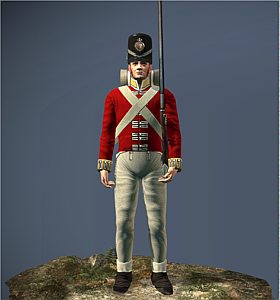Difference between revisions of "Foot (NTW Unit)"
(Created page with "{{unit |image=Image:Foot.png |Class=Line Infantry |Men=160 |Guns=Musket |Recruitable From=Cantonment and above. |Region=Worldwide |Recruitment Cost=620 |Upkeep Cost=200 |Tech...") |
m (updated for new template) |
||
| Line 3: | Line 3: | ||
|Class=Line Infantry | |Class=Line Infantry | ||
|Men=160 | |Men=160 | ||
| − | | | + | |Weaponry=Musket |
| − | | | + | |Minimum Building Requirement=Cantonment |
|Region=Worldwide | |Region=Worldwide | ||
|Recruitment Cost=620 | |Recruitment Cost=620 | ||
Revision as of 23:01, 13 July 2011
Overview
Highly disciplined and calm in the face of the enemy, these men are well trained in line infantry tactics. They can be relied upon to perform their duties with stolid determination rather than with dash and “fire in their bellies”. Their close ranks can make them vulnerable to artillery bombardment and skirmishers, and they will be ripped apart by heavy cavalry charges if they are in line. To counter this last threat, the unit can be ordered to form square. As long as discipline holds, an infantry unit in square should be able to see off enemy cavalrymen.
The weapon of the British line infantryman was the famous ‘Brown Bess’; a flintlock musket used, in various guises, from 1730 to 1830. Other nations had their own standard pattern of musket. The Brown Bess used a large heavy ball that would not fit into French muskets, meaning that British ammunition captured on the battlefield was useless. It could be melted down and recast, but not immediately fired at its former owners.
